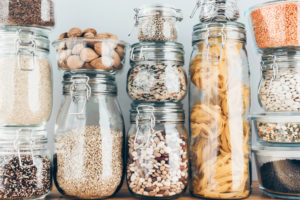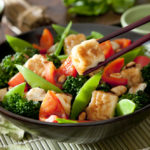Have you ever contemplated vegetarianism or wondered what’s in the cupboards of a vegetarian? Where does she get her protein? Does she live on salads?
Let’s take a look at how varied a vegetarian diet can be.
Of course, a vegetarian diet will be rich in… you guessed it, vegetables! I often have vegetables in my home that others haven’t even heard of. In fact, all diets should be rich in vegetables. Whatever type of diet you’re eating now, an easy way to add more nutrients and to improve your health is to increase your intake of fruits and vegetables.
Let’s cover some of the protein sources in the vegetarian diet.
Some may be new to you and some you may have heard of but not eaten on a regular basis, before now. Get ready to expand your horizons!
- Quinoa
- Tofu
- Tempeh
- Lentils
- Texturized Vegetable protein
- Legumes (chickpeas, black beans, kidney beans, pinto beans, navy beans)
- Farm Fresh eggs
- Goat cheese
- Nuts and seeds

- Hummus
- Nut butters
- Quality protein powder
- Pasta – yes, pasta. Keep reading
Many vegetarians also consume dairy on a regular basis so they will get protein from things like greek yogurt, cheese, kefir, etc. Personally, I stay away from dairy as much as possible (except in the case of pizza where I will always make an exception!). However, I choose goat cheese over cow if I’m making something at home because I like it better and it’s easier for me to digest. I also consume butter (a dairy product) and not the processed vegan spreads available.
I will say that labels make me crazy. Why we feel the need to label ourselves by the diet we eat, is beyond me. It is my firm belief that we should eat what fuels us well, and supports our health and longevity. Period.
Let’s dive into what the protein sources mentioned look like in meals.
I know that some of them are new and scary. Hang in there with me, you’ll see how easy it is. Most of these proteins take significantly less time to cook than meat so you’ll actually find that you spend less time in your vegetarian kitchen than you did when you were cooking meat.
1. Lentils
Can be used to thicken sauces and soups. They cook quickly from dried and can be added to almost anything you’re cooking. They have a very mild flavour that you barely notice in sauces and pack about 9 grams of protein per 1/2 cup.
2. Chickpeas
Are excellent roasted with a bit of olive oil, rosemary, garlic and lemon. In 1/2 cup, you’ll get about 7 grams of protein. Of course, hummus (made from chickpeas) makes a great snack with raw veggies or gluten free crackers.
3. Nut butters
Make an excellent dip for apple and banana slices and keep you feeling full for longer because of their healthy fat and protein content (7 grams per 2 tbsp.)
4. Eggs
Choose farm fresh, local eggs and consume in moderation. I’ve seen many vegetarians rely on eggs as their main source of protein and it’s always better to vary your diet. Cook eggs anyway you choose. Keep mini-quiche or frittata on hand for a quick snack. Hard boiled eggs make great salad toppers. An egg cooked in half an avocado makes a yummy breakfast. Top with some salsa for a bit of kick. Eggs contain approximately 7 grams of protein each.
5. Tofu
Always purchase organic. Tofu will take on the flavour of whatever you cook it with. Experiment with different sauces to see what you like. Tofu takes just 15 minutes or so to cook and can take the place of animal protein in any meal. Eat it hot in any dish or cold on salads. It’s even good cold, dipped in hummus. 1/4 block of tofu contains about 9 grams of protein. Pictured below is a tofu stir fry. Looks yummy, doesn’t it?

6. Tempeh
Always purchase organic – replace bacon with this ! You won’t even miss the bacon on a BLT – promise. Tempeh contains about 8 grams of protein for 1/4 cup and has the appearance of bacon or other strips of meat in a stir fry or sandwich.
7. TVP (texturized vegetable protein)
Always buy organic. TVP has the texture of ground beef in a recipe. It’s great for adding to sauces, stews, minestrone soup, chili. 1/4 cup TVP contains 12 grams of protein.
8. Switch from regular or whole grain pasta to quinoa pasta. It’s naturally gluten free and has 13 grams of protein per serving. No carb crash here!
9. Nuts and seeds
Add to anything and everything. Nuts are a powerhouse of nutrients with selenium and zinc to support the thyroid, healthy fats for brain health, satiety, healthy cholesterol levels, weight management, and more. Nuts are high in fibre too! On average, nuts have anywhere from 6-10 grams of protein per half cup.
Keep nuts and seeds refrigerated as they can go rancid quickly. You won’t believe how much better they taste! Get into the habit of adding nuts and seeds to snacks, smoothies, salads, etc. It’s an easy way to keep yourself feeling full and give your body the proteins and healthy fats it needs while making the transition to vegetarianism.
10. Protein Powder.
I love a good sprouted protein powder and Iron Vegan is my favourite. It leaves no aftertaste (as many vegan powders do) It mixes well and tastes amazing. At 17 grams of protein per scoop, a smoothie with 2 scoops of protein powder can be an excellent start to the day. Make your smoothie into a meal by adding frozen berries, nuts and seeds, greens, and water for mixing.
As you can see, there are many choices for vegetarian protein sources and I’ve not listed them all.
Start experimenting and you’ll be surprised at how easy it is to experience vegetarianism while eating a varied, protein rich diet.
If you’re considering vegetarianism, give yourself Grace and replace things slowly. Start by going vegetarian for a couple of meals a week. Try a new food each week. Collect recipes online and from cookbooks that you want to try. Even reading through vegetarian cookbooks and magazines can give you some inspiration.
Please, please, please, whatever you do, whether you’re trying vegetarianism for your health, for the health of our planet, or to save the animals, do not become a carbo-tarian or a bagel-tarian. It’s a thing. So many times we have the best of intentions and try to do it all at once and then end up being an extremely unhealthy vegetarian. Give yourself the Grace to move slowly and healthily into this new season of your life.
Always remember that baby steps still move us forward
If you’re not sure where to start your vegetarianism, or would love some help getting started, reach out to schedule a discovery session. We’ll dive into what you’re eating now and how you can make some different choices, over time.

